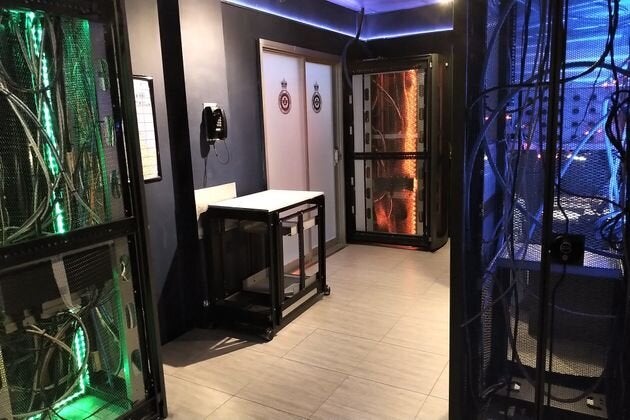OTTAWA — Fittingly, the only person to ever finish an escape room built to find recruits for a Canadian spy agency is shrouded in secrecy.
“I’m not at liberty to say,” Escape Manor co-owner Steve Wilson said when I asked what became of the first escapee. “I can tell you that the CBC reached out to have an interview with said person, and it was not allowed.”
After an hour spent at Ottawa’s Escape Manor, it became clear I wouldn’t be the second.
“The Recruit” escape room is the result of a surprising partnership with the Communications Security Establishment (CSE), responsible for stopping foreign cyber attacks on the Canadian government’s computer systems.
An increase in cyber attacks has compelled the CSE to hire more staff — last year, the agency said it was blocking one billion malicious attempts each day — but its poor name recognition isn’t attracting the number of candidates it needs. According to a 2017 survey conducted by the agency, only three per cent of Canadians knew what the CSE does. As a result, it’s still looking to fill hundreds of job vacancies.
So the CSE contacted Wilson’s team last year with a pitch: to collaborate on an escape room that could ferret out potential code-breakers to help build “innovative tools” or techniques to decrypt communications. (Details are unsurprisingly vague.) The Recruit opened to the public in August.
CSE spokesman Evan Koronewski explained that the goal was to design a “realistic yet fictional escape room scenario.” He told HuffPost that the agency considers itself in direct competition with some of the world’s biggest tech giants, such as Microsoft, Google and Apple, for top talent.
The result is “The Recruit,” a marketing project that cost the CSE less than $25,000. Participants who successfully crack the cryptographic puzzle at the end are given the option of leaving their names for Escape Manor to forward to the CSE.
No one in my six-person group of friends and family made it to that puzzle when we gave “The Recruit” a try on a winter afternoon.

Our spirited host Kaitlyn instructed us to keep our hands off framed art on the walls before she disappeared to get into character. She returned, wearing an oversized blazer, and welcomed us as the CSE’s newest recruits. We were directed to the spy agency’s mock boardroom, complete with the CSE badge on the frosted glass doors.
Expect a boring day of paperwork, Kaitlyn told us, before she excused herself from the room to make a “coffee run.” Ten seconds later, one of my teammates naturally started removing the framed art from the walls in the hunt for clues.
Suddenly, Kaitlyn’s voice came through a speaker. An alarm. Red lights. It’s a lockdown.
We were told a fictional adversary called “The Syndicate” had launched a cyber attack on the global computer network: “You have only 45 minutes before this virus literally takes down the entire world.”
We began to scramble — and continued to do so for 45 minutes.
Some escape-room players can become obsessed about getting the best time. The competitive element can even seduce certain people into doing really stupid things.
“Some people get a little too creative,” Kaitlyn explained. “So they’ll come in with screwdrivers or bolt cutters just to really get rid of that time to figure out what the lock combinations are.”
Even that’s not the wildest thing she’s seen. One time a group organized themselves into a human pyramid so they could pop the ceiling panels to look for clues. Because of this spectacular and futile exhibition of human ingenuity, employees now instruct participants that reaching anything above a certain height isn’t necessary.
We just focused on finishing. In retrospect, stronger communication would have helped. It didn’t take long for our group of confident 30-somethings to splinter off into six freelancers locked in a room together.
There are three rooms in “The Recruit,” and it took us 14 minutes to clear the first one. We tumbled into the second room, exploring colourful server cages. Fake memos are stapled onto cork boards, and I admired an extremely nerdy detail: Harjit Sajjan’s name, the minister responsible for CSE in real life.
The time ticks by. Encrypted phone calls. Cables pulled and reattached. Some playful mockery about being bad spies.
Ten seconds left. A beeping countdown begins. We open another lock. Beep. Someone makes a dash to a card reader. Beep. A supportive teammate shouts “Go go go!” Beep. A door to the third and final room opens, but it’s too late. Beeeeeeep.
No thrilling spy careers for us. Instead, the six of us left to grab doughnuts.
“Not a lot of people escape,” Wilson told me. But winning isn’t the only point. “We built the company to bond friendships and gel families and build teams.”
The Ottawa business he started with three friends five years ago has grown to 13 locations around the world, including locations in Australia and the Cayman Islands. Despite the rapid evolution, he never expected one of their rooms would help a real-life spy agency.
“The Recruit” is alluring because it indulges that fantasy. The remote chance of snagging a real-life job at an intelligence agency pulls you forward.
And the unorthodox recruitment and promotion strategy seems to be paying off. The escape room, which Koronewski said “accurately represents CSE’s role in a fictional scenario,” is being extended beyond its original six-month run through to next summer.
Calling all HuffPost superfans!
Sign up for membership to become a founding member and help shape HuffPost’s next chapter
Credit: Source link